The Wireless Power Bank Market is estimated to be valued at USD 6.2 billion in 2025 and is projected to reach USD 9.9 billion by 2035, registering a compound annual growth rate (CAGR) of 4.9% over the forecast period. The compound absolute growth analysis highlights steady and consistent growth throughout the forecast period.
From 2025 to 2029, the market grows from USD 4.9 billion to USD 6.2 billion, reflecting a steady rise driven by the increasing adoption of wireless charging technology and the growing demand for convenient charging solutions in consumer electronics, particularly smartphones and portable devices.
Between 2029 and 2031, the market sees moderate growth, moving from USD 6.5 billion to USD 6.8 billion. This period marks a more stable phase, with demand for wireless power banks continuing to expand as the technology becomes increasingly mainstream, and consumer preferences shift towards convenience and portability.
From 2031 to 2035, the market experiences more substantial growth, reaching USD 9.9 billion by 2035. This phase is driven by technological advancements in charging efficiency, larger battery capacities, and increasing consumer interest in multi-device charging solutions. As wireless charging solutions continue to gain popularity and expand across different consumer devices, the market experiences a steady rise in demand. The compound growth analysis underscores sustained and gradual market expansion, propelled by continuous innovation and the growing need for efficient, portable power solutions.
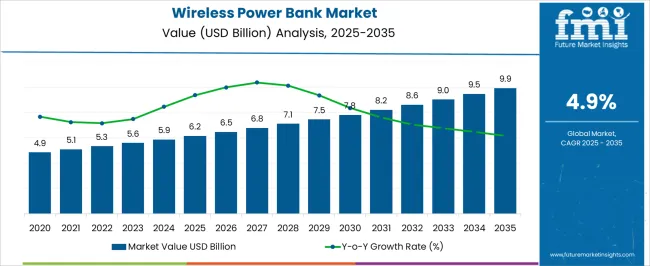
| Metric | Value |
|---|---|
| Wireless Power Bank Market Estimated Value in (2025 E) | USD 6.2 billion |
| Wireless Power Bank Market Forecast Value in (2035 F) | USD 9.9 billion |
| Forecast CAGR (2025 to 2035) | 4.9% |
The wireless power bank market is gaining significant traction as consumers increasingly seek convenience, mobility, and faster charging solutions in their daily device usage. Innovations in wireless charging protocols, coupled with improved power efficiency and form factor designs, have supported the rise of wireless power banks as essential accessories for modern digital ecosystems. The increased penetration of smartphones, the growing adoption of wearable technology, and the rise of remote work culture have collectively driven up demand for portable energy storage.
Standardization efforts and enhanced interoperability between devices have supported the shift toward contactless power transfer. Manufacturers have prioritized improvements in charging speed, safety, and power density, responding to a tech-savvy user base that expects minimal downtime and on-the-go flexibility.
The market is also experiencing increased investment in sustainable battery components and temperature regulation features, creating opportunities for product differentiation. With expanding device ecosystems across consumer and enterprise segments, wireless power banks are expected to remain integral to personal electronics support infrastructure, with future demand reinforced by the growing ecosystem of wirelessly chargeable devices.
The wireless power bank market is segmented by battery type, capacity range, application, end-use, charging technology, and geographic region. By battery type, the wireless power bank market is divided into Lithium-ion and Lithium polymer. In terms of capacity range, the wireless power bank market is classified into 8,001 mAh-20,000 mAh, up to 3,000 mAh, 3,001 mAh- 8,000 mAh, and above 20,000 mAh.
Based on application, the wireless power bank market is segmented into smartphones, tablets, laptops, Wearable devices, and Others (headsets, cameras). By end use, the wireless power bank market is segmented into Individual/consumer, Commercial, and Industrial. By charging technology, the wireless power bank market is segmented into Inductive charging, Resonant charging, and RF energy harvesting. Regionally, the wireless power bank industry is classified into North America, Latin America, Western Europe, Eastern Europe, Balkan & Baltic Countries, Russia & Belarus, Central Asia, East Asia, South Asia & Pacific, and the Middle East & Africa.
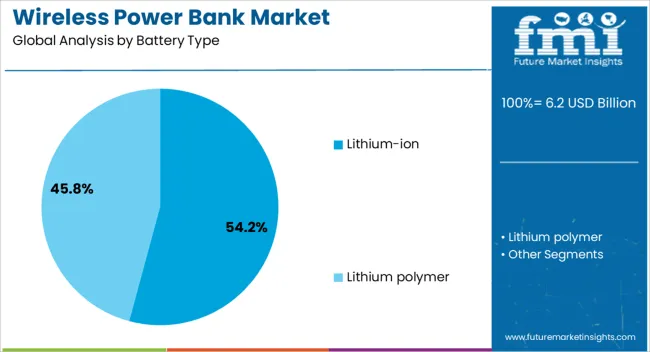
The lithium-ion battery type segment is projected to contribute 54.2% of the overall wireless power bank market revenue in 2025, making it the dominant battery technology. The widespread use of lithium-ion batteries has been attributed to their superior energy density, lightweight design, and long lifecycle, which align with the performance needs of compact and portable charging solutions.
Their ability to support fast charging, combined with lower self-discharge rates, has made lithium-ion a preferred choice for wireless power bank manufacturers. Advancements in thermal management and battery safety technologies have further enhanced user confidence, particularly in high-usage scenarios.
The compatibility of lithium-ion batteries with wireless energy transmission modules and their adaptability to compact form factors have supported their scalability across various power capacitie.s The segment’s growth is also being influenced by the ease of integration with smart battery management systems, allowing better voltage control and temperature monitoring, which are essential for the safe and efficient operation of wireless charging systems.

The 8001 mAh to 20000 mAh capacity range segment is expected to account for 36.8% of the total revenue share in the wireless power bank market in 2025. This capacity range has gained preference due to its optimal balance between portability and power output, meeting the charging demands of multiple devices over extended periods. Consumers are increasingly opting for this segment to ensure uninterrupted usage of smartphones, tablets, and wearable devices during travel or prolonged outdoor activities.
The ability to deliver multiple full charges to modern high-capacity smartphones has made this segment attractive to both casual and professional users. In addition, the incorporation of fast charging protocols such as Power Delivery and Quick Charge within this capacity bracket has further enhanced its appeal.
Manufacturers have been focusing on reducing the overall weight and thickness of power banks within this range, ensuring they remain compact while offering substantial power backup The segment’s scalability across retail and enterprise distribution channels has also reinforced its market share.
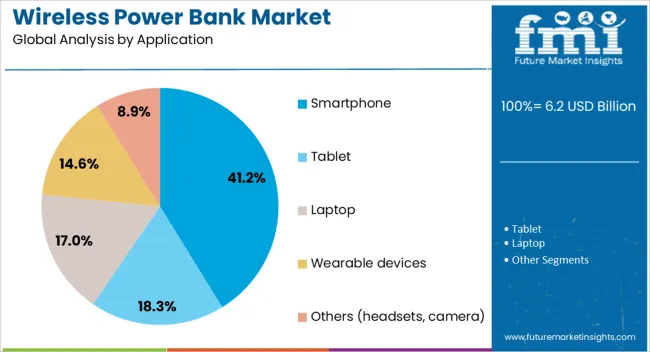
The smartphone application segment is anticipated to represent 41.2% of the wireless power bank market’s revenue in 2025, maintaining its status as the primary end-use category. The widespread dependency on smartphones for communication, entertainment, productivity, and navigation has created consistent demand for reliable, portable charging solutions. The growth of battery-intensive features such as high-refresh-rate displays, advanced mobile gaming, and 5G connectivity has elevated the need for on-the-go power sources.
Wireless power banks designed specifically for smartphones often feature magnetic alignment, overcharge protection, and compatibility with major mobile operating systems, which has enhanced their utility. The segment's dominance is also reinforced by the rising trend of multi-device households, where each user often relies on a primary smartphone.
Continuous innovation in coil design, heat dissipation, and energy conversion efficiency has supported broader consumer adoption. As mobile usage continues to expand across both personal and professional domains, the smartphone segment is expected to retain its lead within the wireless power bank ecosystem.
The wireless power bank market is growing rapidly due to the increasing demand for portable and convenient charging solutions. Wireless power banks, which eliminate the need for traditional cables, offer consumers the flexibility to charge their devices on the go without the hassle of plugging in cables. The growing adoption of smartphones, wearables, and other portable electronic devices is fueling the demand for wireless charging solutions. As technology advances, wireless power banks are becoming more efficient, compact, and capable of charging multiple devices simultaneously, further driving their popularity in consumer electronics.
The wireless power bank market is primarily driven by the increasing adoption of wireless charging technology in smartphones, tablets, and other electronic devices. As more devices are integrated with wireless charging capabilities, the demand for wireless power banks is growing. Consumers appreciate the convenience of charging their devices without the need for physical connectors, making wireless power banks an attractive option. The expansion of wireless charging standards, such as Qi, and the growing compatibility of devices with wireless charging further support market growth. As more consumers seek convenient, hassle-free charging solutions, the demand for wireless power banks is expected to continue rising.
Despite its growth, the wireless power bank market faces challenges, particularly with high production costs and limited charging speed compared to wired alternatives. The technology behind wireless charging is still evolving, and creating power banks with fast charging capabilities requires specialized components and materials, which can increase production costs. Wireless charging is generally slower than wired charging, which may deter some consumers who prioritize quick charging. The market must address these challenges by improving charging speeds and reducing costs to make wireless power banks more appealing to a wider audience and compete with traditional wired charging options.
The wireless power bank market presents significant opportunities driven by technological advancements and increased consumer demand. As manufacturers continue to improve the efficiency of wireless charging technology, faster charging speeds, and longer-lasting batteries are becoming more common in wireless power banks. The growing popularity of wearables, such as smartwatches and fitness trackers, presents new opportunities for wireless power banks, as these devices require portable, convenient charging solutions. With more devices adopting wireless charging technology and consumers seeking multifunctional, compact, and portable solutions, the market for wireless power banks is expected to grow, creating opportunities for innovation and expansion in the consumer electronics sector.
A key trend in the wireless power bank market is the increasing demand for multi-device charging and the integration of smart features. Consumers are looking for power banks that can charge multiple devices simultaneously, such as smartphones, tablets, wearables, and wireless headphones. This has led to the development of wireless power banks with multiple charging pads and higher capacities. Additionally, the integration of smart features, such as LED indicators, smartphone app compatibility for monitoring charging status, and adaptive charging modes, is becoming more common. These trends are enhancing the functionality of wireless power banks and making them more appealing to tech-savvy consumers. As demand for such advanced features continues to grow, the market for wireless power banks is expected to see further innovation and expansion.
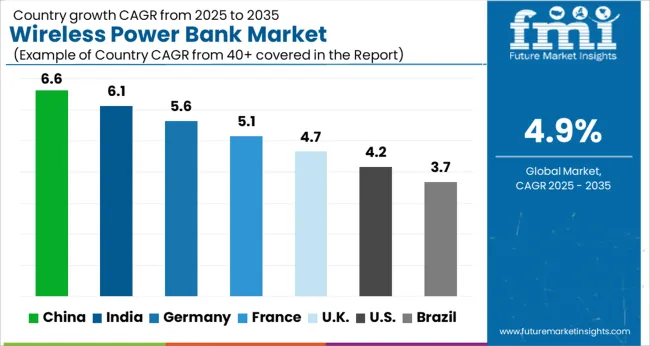
| Country | CAGR |
|---|---|
| China | 6.6% |
| India | 6.1% |
| Germany | 5.6% |
| France | 5.1% |
| UK | 4.7% |
| USA | 4.2% |
| Brazil | 3.7% |
The global wireless power bank market is projected to grow at a CAGR of 4.9% from 2025 to 2035.China leads at 6.6%, followed by India at 6.1%, and France at 5.1%, while the United Kingdom records 4.7% and the United States posts 4.2%. These rates translate to a growth premium of +35% for China, +25% for India, and +5% for France versus the baseline, while the United States and the United Kingdom show slower growth. Divergence reflects local catalysts: the growing adoption of wireless charging technologies, increasing consumer demand for mobile devices, and the rise in e-commerce in China and India, while more mature markets like the United States and the United Kingdom experience more moderate growth due to established infrastructure. The analysis includes over 40+ countries, with the leading markets detailed below.
The wireless power bank market in China is growing at a 6.6% CAGR through 2035. The rapid adoption of smartphones, wearables, and other portable devices, along with the increasing demand for wireless charging solutions, is driving the growth of wireless power banks in China. The country's rapidly expanding e-commerce sector and increasing disposable income are key factors contributing to the rising demand for wireless power banks. China’s growing focus on technological innovation and the adoption of cutting-edge electronics further accelerates the need for portable charging solutions. Additionally, China’s extensive manufacturing base allows for large-scale production and competitive pricing, driving the market forward.
The wireless power bank market in India is projected to grow at a 6.1% CAGR through 2035. With the rapid increase in smartphone penetration and the growing trend of mobile device usage, India’s demand for wireless power banks is expanding. The rise in disposable income and urbanization has led to a surge in consumer demand for convenient charging solutions. As more people embrace wireless charging technologies, the market for wireless power banks is expected to continue growing. India’s focus on expanding its digital infrastructure, coupled with the increasing number of mobile-first consumers, further drives the adoption of these portable power solutions.
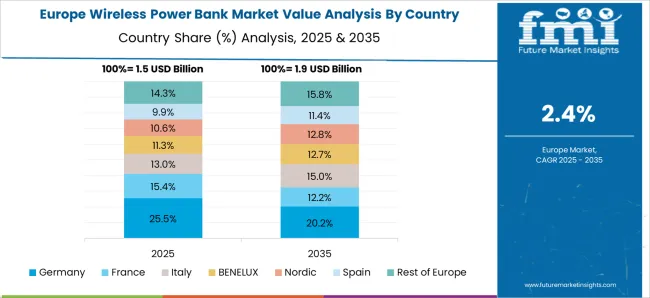
Demand for wireless power banks in France is growing at a 5.1% CAGR through 2035. France’s tech-savvy consumer base, coupled with the increasing demand for convenient and portable charging solutions, is driving the adoption of wireless power banks. The rise in smartphone usage, wearables, and other portable electronics is contributing to the growing market for wireless charging devices. The country’s focus on enhancing its infrastructure for smart cities and digital technologies further accelerates demand for wireless power banks. Moreover, the growing trend of mobile payments and digital services is contributing to the increased demand for wireless charging solutions.
The UK market for wireless power banks is expected to grow at a 4.7% CAGR through 2035. The UKs demand for wireless power banks is being driven by the increasing adoption of smartphones, wearables, and other portable electronic devices. The shift towards mobile-first solutions, such as mobile payments and digital services, is further accelerating the market for wireless charging products. Additionally, as the UK continues to embrace wireless technologies and connected devices, the need for convenient and efficient charging solutions continues to rise. The growing trend of sustainability and energy efficiency in consumer electronics further supports the demand for wireless power banks in the UK.
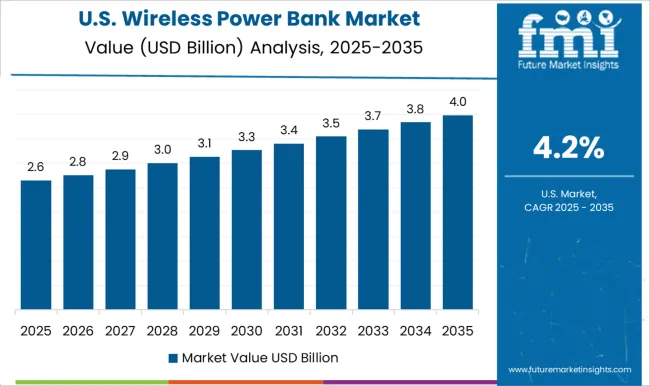
Demand for wireless power banks in the USA is projected to grow at a 4.2% CAGR through 2035. The growing adoption of smartphones, portable electronics, and wearable devices primarily drives the USA market for wireless power banks. The rise in digital transformation, particularly the shift toward mobile payments, digital wallets, and connected devices, contributes to the increasing demand for wireless charging solutions. The USA government’s push for cleaner, more energy-efficient technologies in consumer electronics further supports the growth of wireless power banks. As more people adopt wireless charging systems, the demand for portable charging solutions is expected to continue rising.
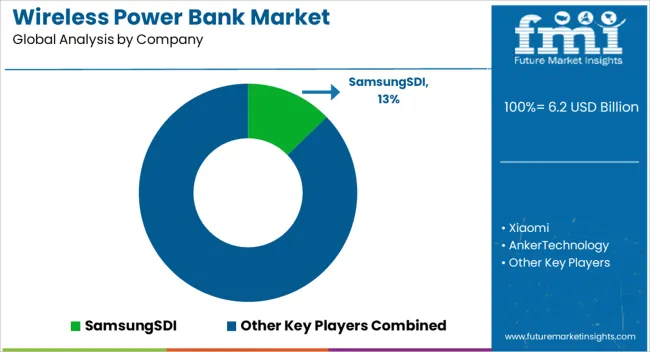
The wireless power bank market is driven by leading companies offering high-performance and convenient charging solutions that cater to the growing demand for portable and wireless energy storage devices. Samsung SDI is a key player, providing advanced battery technology for wireless power banks, with a focus on high-capacity, efficient, and reliable power solutions. Xiaomi is another major player, offering affordable wireless power banks with sleek designs, catering to a wide consumer base, and focusing on innovation and user-friendly features.
Anker Technology is recognized for its high-quality wireless power banks, known for their fast-charging capabilities, reliable performance, and extensive product range for both personal and professional use. Philips provides wireless power banks with a focus on safety, durability, and ease of use, catering to the growing demand for wireless charging solutions. Sony offers advanced wireless power banks, focusing on efficiency and the integration of smart features to provide convenient, fast, and safe charging options. ADATA Technology is known for producing high-performance wireless power banks designed for users seeking portability and reliable power, with a focus on speed and safety. Ambrane India specializes in affordable wireless power banks, offering products designed for the Indian market, with an emphasis on value for money and high capacity. Lenovo offers wireless charging solutions that integrate advanced technology for smooth, fast, and reliable charging. Panasonic provides wireless power banks that focus on energy efficiency, long battery life, and quick charging. Baseus Technology and Aukey offer a wide range of wireless power banks with a focus on premium quality, fast-charging features, and sleek, modern designs. Intex Technologies manufactures wireless power banks that combine affordable pricing with reliable performance for consumers in both urban and rural markets. Microsoft and Ravpower provide wireless power banks with high efficiency, safety features, and advanced technology, catering to consumers looking for high-performance mobile charging solutions. Syska offers affordable wireless power banks designed for Indian consumers, focusing on user-friendly features and cost-effectiveness.
ASUS provides high-quality wireless charging solutions for tech-savvy consumers, with a strong focus on performance and reliability. Energizer offers a variety of wireless power banks with advanced features, including fast charging and safety protocols, designed for a wide range of devices. Cellularline specializes in wireless charging solutions for mobile devices, ensuring fast, reliable charging. Omnicharge and Zendure offer premium wireless power banks known for their durability, compact design, and high capacity, catering to both consumer and professional markets.
| Item | Value |
|---|---|
| Quantitative Units | USD 6.2 Billion |
| Battery Type | Lithium-ion and Lithium polymer |
| Capacity Range | 8,001 mAh-20,000 mAh, Up to 3,000 mAh, 3,001 mAh-8,000 mAh, and Above 20,000 mAh |
| Application | Smartphone, Tablet, Laptop, Wearable devices, and Others (headsets, camera) |
| End Use | Individual/consumer, Commercial, and Industrial |
| Charging Technology | Inductive charging, Resonant charging, and RF energy harvesting |
| Regions Covered | North America, Europe, Asia-Pacific, Latin America, Middle East & Africa |
| Country Covered | United States, Canada, Germany, France, United Kingdom, China, Japan, India, Brazil, South Africa |
| Key Companies Profiled | SamsungSDI, Xiaomi, AnkerTechnology, Philips, Sony, ADATATechnology, AmbraneIndia, Lenovo, Panasonic, BaseusTechnology, Aukey, IntexTechnologies, Microsoft, Ravpower, Syska, ASUS, Energizer, Cellularline, Omnicharge, and Zendure |
| Additional Attributes | Dollar sales by product type (wireless charging power banks, solar wireless power banks, multi-device wireless power banks) and end-use segments (consumer electronics, business, outdoor activities, emergency use). Demand dynamics are driven by the increasing need for portable, fast, and convenient charging solutions, the growth of wireless technology, and the rising adoption of mobile devices. Regional trends indicate strong growth in North America, Europe, and Asia-Pacific, with technological advancements, the growing smartphone and portable device market, and consumer preference for wireless convenience driving market expansion. |
The global wireless power bank market is estimated to be valued at USD 6.2 billion in 2025.
The market size for the wireless power bank market is projected to reach USD 9.9 billion by 2035.
The wireless power bank market is expected to grow at a 4.9% CAGR between 2025 and 2035.
The key product types in wireless power bank market are lithium-ion and lithium polymer.
In terms of capacity range, 8,001 mah-20,000 mah segment to command 36.8% share in the wireless power bank market in 2025.






Full Research Suite comprises of:
Market outlook & trends analysis
Interviews & case studies
Strategic recommendations
Vendor profiles & capabilities analysis
5-year forecasts
8 regions and 60+ country-level data splits
Market segment data splits
12 months of continuous data updates
DELIVERED AS:
PDF EXCEL ONLINE
Wireless Access Point Market Size and Share Forecast Outlook 2025 to 2035
Wireless Video - 2.4/5GHz Market Size and Share Forecast Outlook 2025 to 2035
Wireless Polysomnography Market Size and Share Forecast Outlook 2025 to 2035
Wireless Audio Devices Market Size and Share Forecast Outlook 2025 to 2035
Wireless Communication Technologies In Healthcare Market Size and Share Forecast Outlook 2025 to 2035
Wireless Mesh Network Market Size and Share Forecast Outlook 2025 to 2035
Wireless Sensor Tags Market Size and Share Forecast Outlook 2025 to 2035
Wireless Sensor Network Market Size and Share Forecast Outlook 2025 to 2035
Wireless Home Security Camera Market Size and Share Forecast Outlook 2025 to 2035
Wireless Testing Market Size and Share Forecast Outlook 2025 to 2035
Wireless Battery Monitoring System Market Size and Share Forecast Outlook 2025 to 2035
Wireless Printer Market Size and Share Forecast Outlook 2025 to 2035
Wireless Headphones Market Size and Share Forecast Outlook 2025 to 2035
Wireless Sensors Market Size and Share Forecast Outlook 2025 to 2035
Wireless Display Market Size and Share Forecast Outlook 2025 to 2035
Wireless Paging Systems Market Size and Share Forecast Outlook 2025 to 2035
Wireless Patient Monitoring Market Size and Share Forecast Outlook 2025 to 2035
Wireless Earphone Market Size and Share Forecast Outlook 2025 to 2035
Wireless Ev Charging Market Size and Share Forecast Outlook 2025 to 2035
Wireless Telecommunication Services Market Trends – Growth & Forecast through 2035

Thank you!
You will receive an email from our Business Development Manager. Please be sure to check your SPAM/JUNK folder too.
Chat With
MaRIA